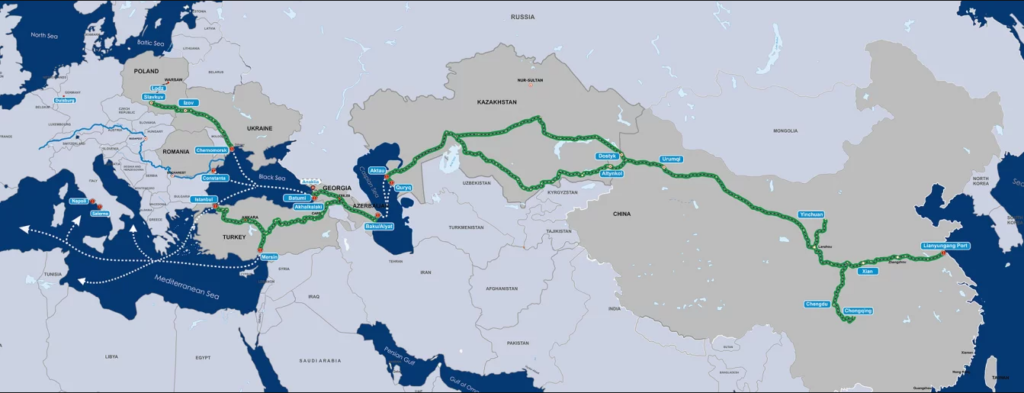Tokyo, 9 July, /AJMEDIA/
The conflict between Russia and Ukraine, lasting more than three months, gave rise to outsized impact which affected almost the entire world. The global supply chain, which has already been under stress during the COVID-19 pandemic, has been particularly hard hit. The Western sanctions imposed on Russia are forcing giant companies with a worldwide reputation unwilling to conduct operations through the country’s territory – no one has a desire to become an outcast. More than ever the world needs to diversify its trade and transport routes and restructure its logistics flows. As a result, a growing number of international carriers have announced rescheduling transit routes in order to maintain competitiveness in the face of current forces.
Against the backdrop of all that is happening, the China-to-Europe transportation route, which mainly kept its way through the Russian territory – about 90 percent of all rail traffic in this direction – has suffered great damage. For several years, the import of Chinese goods to Europe has been growing rapidly, the Celestial Empire has even outstripped the United States as a trading partner of European countries. Chinese economy has a high dependence on exports: in the 1990s, export growth averaged 40 percent of total GDP growth, and in the 2000s, its share increased to almost 60 percent. And it is not in the interests of Beijing to surrender the leading position of supply chain giant against the background of the emerging logistical crisis.
Now that global events have weakened the competitiveness of the Northern Corridor and created new opportunities for the East-West route, the interest in the Middle Corridor is increasing and countries have begun to actively contribute to the development of the project. Now, what if the possibility of returning to the old supply chain in the foreseeable future seems hazy, and Russia which territory occupies about 36.2 percent of the Earth’s total land area “falls out” of the game? Perhaps the leading exporting countries are asking the same question. The so-called Middle Corridor, which stretches between sanctioned Russia and Iran and runs along the route China – Kazakhstan – Caspian Sea – Azerbaijan – Georgia – Turkey or the Black Sea -Europe, is the most obvious alternative. A positive trend in the development of the route was observed over the course of several years, and increased sharply after the onset of the Russian-Ukrainian crisis. Now, in the face of increased demand, countries began to work more actively to improve the infrastructure of the route and facilitate many customs processes – it all had a positive impact on the figures. In the first four months of this year, 8696 containers passed through the territory of Azerbaijan, which is 130 percent more than in the previous year, and this trend is expected to continue growing. The average volume of both land and sea transport has already increased by 52 percent.
All participants in the Middle Corridor have their own reasons and interests in why the development of the route has entered an active phase, in particular, for the South Caucasus, which has overcome many difficulties. This is an opportunity to increase their power and infrastructure, and for the countries of Central Asia this may be a way out of the crisis and the impetus for economic recovery. The activation of the Central Asian countries also lies in the plane of another problem – they are most connected with Russia by transport and logistics ties and, given recent events, the development of new transport routes is of a strategic nature for Central Asia.
Active phase
The countries of the Trans-Caspian International Corridor (TITR), an important trench of the Middle Corridor, Azerbaijan, Kazakhstan and Georgia, are planning to expand the capacity of the route, currently estimated at 10 million metric tons or 200,000 containers per year, establish uniform tariffs for domestic shippers, and improve and simplify the work of carriers. In addition, after Azerbaijan’s victory in the Second Karabakh War, Baku is working hard to ensure political stability, form a legal framework, diversify routes and speed up the delivery of goods. The TITR countries agreed to establish an enterprise that will deal with the issues of end-to-end tariff setting, cargo declaration, the use of unified IT solutions as well as the consolidation of transit cargo – these aspects were mentioned in the study conducted by the World Bank.
“Customs in Azerbaijan and Georgia have improved in recent years. Based on survey results, there are no significant issues in Georgia, while in Azerbaijan, users noted that customs have made … positive changes in recent years”.
World Bank study
The total volume of cargo transshipment also increased at the International Sea Port, an important part of the Trans-Caspian International Transport Route, by 14.6 percent in 2021, which amounted to 5.6 million tons, while more than 5.1 million tons or 92.7 percent of the total loading is a transit cargo.

